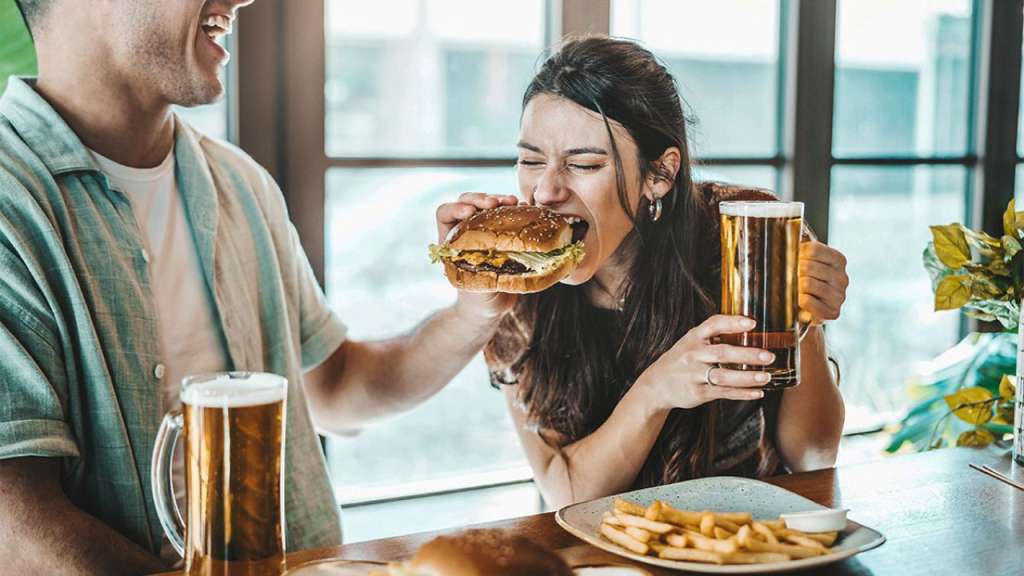A juicy burger can be a delicious treat for a quick lunch or a casual dinner, and you can find a fast food burger on every corner. However, despite their deliciousness, burgers can contribute to weight gain and have other harmful effects on your health. A healthier approach is to save burgers for occasional treats and opt for healthier alternatives instead.
You will gain weight if you eat more calories than you burn, and burgers can be a high-calorie food. A double burger with mayonnaise has 942 calories and your meal could have even more calories if you ordered onion rings or fries, with 480 calories per large order and a regular soft drink. often. A burger without mayonnaise is more suitable for a weight control diet because it contains only 232 calories. Another way to limit the calories in your burgers is to skip the dumplings.

Hamburgers can be high in cholesterol and saturated fat. Cholesterol and saturated fat in the diet can raise blood cholesterol levels and increase the risk of heart disease. A double burger with mayonnaise contains 22 grams of saturated fat, or 108% of the Daily Value, and 172 milligrams of cholesterol, or 57% of the Daily Value based on a 2,000-calorie diet. Reduce your intake by choosing a mayo-free burger, which contains 4 grams of saturated fat and 26 milligrams of cholesterol. Cholesterol is only found in foods of animal origin, and veggie burgers do not contain cholesterol.
Hamburgers can be high in sodium, with a double burger with mayonnaise containing 1,081 milligrams. A small burger without mayonnaise contains only 258 milligrams of sodium. A diet high in sodium can lead to high blood pressure and an increased risk of heart disease, stroke, and kidney disease. Healthy adults should consume no more than 2,300 milligrams of sodium per day. Limit your sodium intake by avoiding salty condiments, such as pickles, which contain 164 milligrams of sodium per tablespoon.
Burgers can replace healthier foods in your diet, and choosing burgers over more nutritious options can lead to overall diet quality worse. A popular option for a healthier lunch at fast food restaurants is a green salad with grilled skinless chicken and pecans, almonds, or walnuts. If you order a burger, choose the smaller one and order a salad or a cup of fresh fruit instead of fries or another fried dish.
A typical double cheeseburger and large fries contain more than 1,100 calories. Add a large soda and spread the potatoes with bacon and cheese, and you can save almost a day of calories at lunch. When you take in more calories than you burn through digestion, metabolism, and exercise, you store the excess calories as fat and over time you can become overweight or fat.
Many studies have shown that eating away from home is associated with weight gain and related health problems. One such analysis, the CARDIA study, looked at the number of times 3,000 young adults ate fast food or sit-down restaurants and compared weight, waist circumference, and other metabolic measurements.

Researchers reporting in the Journal of Nutrition found that people who ate the most fast food at the start of the study weighed an average of 13 pounds and were inches taller than those who ate the least amount of fast food.
A quarter pound of McDonald’s with cheese and condiments contains 1,360 milligrams of sodium. According to the American Heart Association, that number is closer to 1,500 milligrams, so ideally, most adults with high blood pressure should limit their salt intake throughout the day. Read the nutrition label and you’ll know how quickly milligrams of sodium can add up.
A study presented at the American College of Cardiology found that average daily sodium intake increased by 3,100 milligrams over the 14-year study period. Researchers found that people with high blood pressure consumed an average of 2,900 milligrams of sodium per day in 1999, a figure that rose to 3,350 mg per day in 2012.





